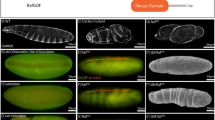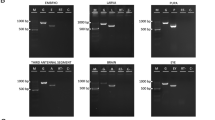Abstract
The homoeobox gene zerknüllt (zen) plays an important role in the differentiation of dorsal tissues during Drosophila development1,2. zen– embryos show transformations in the dorsal-most regions of the fate map, and lack several tissues that normally derive from these regions, including the amnioserosa and optic lobe1. zen displays a simple dorsal on/ventral off pattern as early as cleavage cycle 10–11 (ref. 2). We have prepared a polyclonal antibody against a full-length zen protein, and used this to examine its pattern of expression in mutants that disrupt dorsal–ventral polarity. Most or all of the maternally expressed genes that are involved in this process have been previously identified and fall into two classes, so called 'dorsalizers' and 'ventralizers' (see refs 4–7, reviewed in ref. 8). On the basis of our analysis of zen expression in each of these maternal mutants we propose that one or more of the dorsalizing genes encodes a represser which inhibits the expression of zen in ventral regions of developing embryos. The ventralizing gene cactus7 might play an important role in restricting the activity of this represser to ventral regions, thereby permitting the activation of zen in those dorsal tissues where its function is critically required.
This is a preview of subscription content, access via your institution
Access options
Subscribe to this journal
Receive 51 print issues and online access
$199.00 per year
only $3.90 per issue
Buy this article
- Purchase on SpringerLink
- Instant access to full article PDF
Prices may be subject to local taxes which are calculated during checkout
Similar content being viewed by others
References
1. Wakimoto, B. T., Turner, F. R. & Kaufman, T. C. Devl Biol 102, 147–172 (1984). 2. Doyle, H. ]., Harding, K., Hoey, T. & Levine, M. Nature 323, 76–79 (1986). 3. Levine, M. & Harding, K. Oxford Survey on Eukaryotic Genes 5, (in the press). 4. Anderson, K. V. & Nusslein-Volhard, C. Nature 311, 223–227 (1984). 5. Anderson, K. V., Jurgens, G. & Nusslein-Volhard, C. Cell 42, 779–789 (1985). 6. Anderson, K. V., Bokla, L. & Nusslein-Volhard, C. Cell 42, 791–798 (1985). 7. Godt, D. thesis, Univ. Munchen (1984). 8. Anderson, K. V. Trends genet. Sci. 3, 91–97 (1987). 9. Rushlow, C., Doyle, H., Hoey, T. & Levine, M. Genes Dev. (in the press). 10. Campos-Ortega, J. & Hartenstein, V. in The Embryonic Development of Drosophila melanogaster 31–36 (Springer, Berlin, 1986). 11. Schupbach, T. & Wieschaus, E. Roux Arch. dev. Biol. 195, 302–317 (1986). 12. Studier, F. W. & Moffat, B. A. J. molec. Biol. 189, 113–130 (1986). 13. Frasch, M., Hoey, T., Rushlow, C., Doyle, H. & Levine, M. EMBO J. 6, 749–759 (1987).
Author information
Authors and Affiliations
Rights and permissions
About this article
Cite this article
Rushlow, C., Frasch, M., Doyle, H. et al. Maternal regulation of zerknüllt: a homoeobox gene controlling differentiation of dorsal tissues in Drosophila. Nature 330, 583–586 (1987). https://doi.org/10.1038/330583a0
Received:
Accepted:
Issue date:
DOI: https://doi.org/10.1038/330583a0
This article is cited by
-
Prediction and analysis of cis-regulatory elements in Dorsal and Ventral patterning genes of Tribolium castaneum and its comparison with Drosophila melanogaster
Molecular and Cellular Biochemistry (2024)
-
Population differences in host use by a seed-beetle: local adaptation, phenotypic plasticity and maternal effects
Oecologia (2006)
-
Molecular characterization of the zerknüllt region of the Antennapedia complex of D. subobscura
Chromosoma (1995)
-
Effects of calcium input/output on the stability of a system for calcium-regulated viscoelastic strain fields
Journal of Mathematical Biology (1990)
-
The molecular genetics of embryonic pattern formation in Drosophila
Nature (1988)



